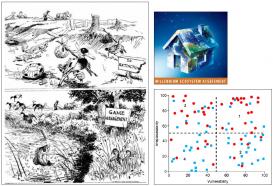Conservation biology is an unusual science in that it was founded on explicitly ethical objectives. Global biodiversity is considered to be a good in its own right and the study and protection of biodiversity itself a scientific and moral imperative. This project investigated the material and conceptual practices of conservation biology, including its forms of reasoning and standards for objectivity, its sites of activity as well as its methods for engaging (or failing to engage) various organizations and communities in conservation. A theme running through much of conservation science is an orientation toward future implications and policy, often taking the form of scenario construction and analysis. One goal of this project was to elucidate more generally the scale-dependence (spatially and temporally) of forms of reasoning in conservation science.
Using a mixed-methods research design, the first part of this study focused on the macrosocial level of conservation research institutions and agencies in order to develop a picture of the standard professional trajectories and modes of collaboration in the discipline. Despite burgeoning interest in the role of advocacy in conservation biology, the actual practices and activities of conservation scientists have not been systematically studied. As a first step to bridging this gap, I surveyed and interviewed conservation scientists as well as conducting a “census” of academic conservation programs. While never complete, this macrosocial picture of the field is important because the activities, attitudes and normative commitments of conservation scientists both structure and are structured by wider conservation priorities, institutional arrangements, and flows of resources globally.
The second part of this study was an ethnographic and discourse-based study of several conservation projects, contemporary and historical, which instantiate the major methodological and conceptual trends of the field (ranging from genetic sequencing to reserve design). The final part of this study looked at “human dimensions” research in conservation biology and the attempt to motivate appropriate conservation behaviors and sentiments among non-conservationists.

